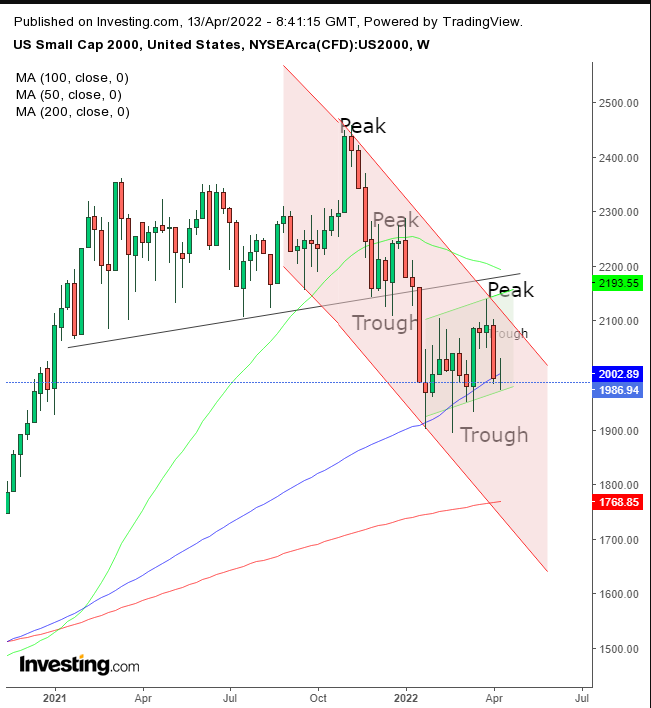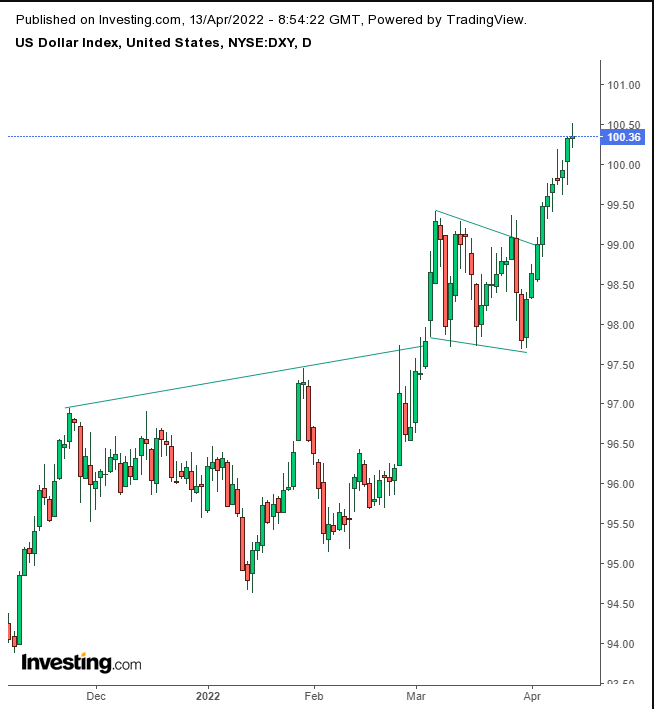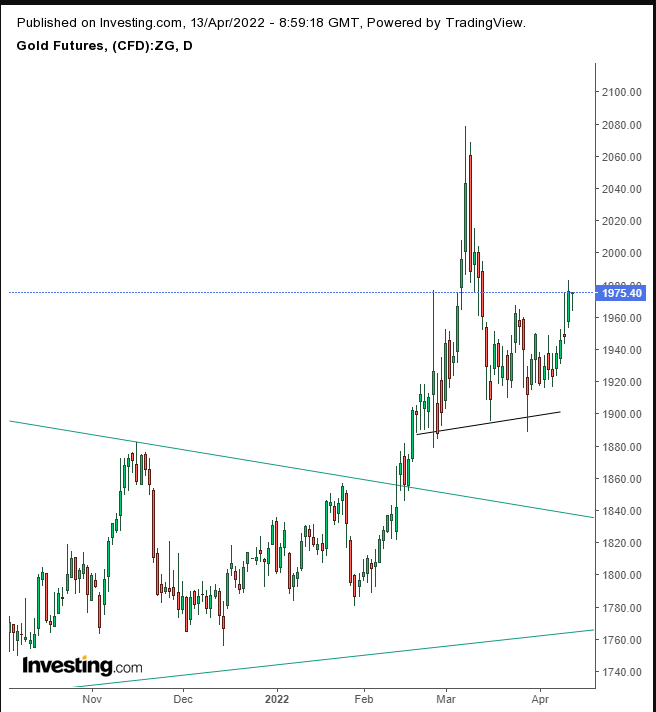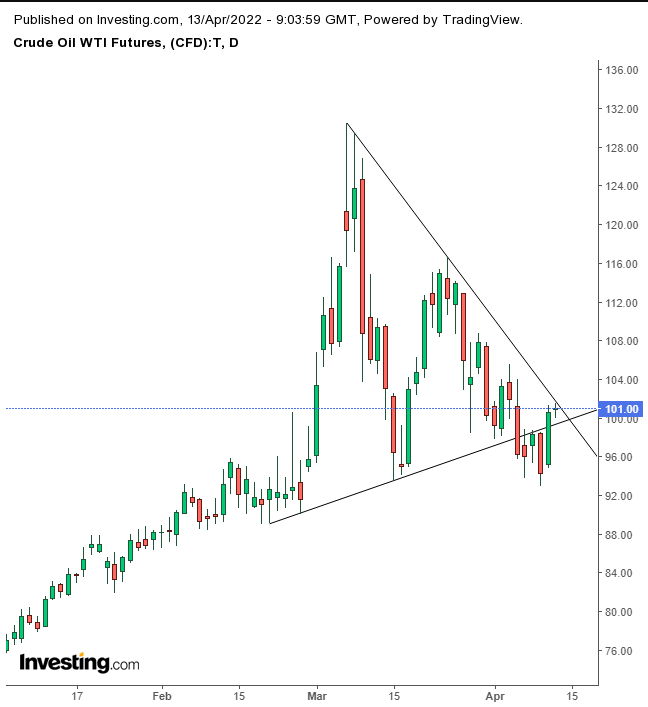- US inflation figures elicit a mixed response
- Oil prices surge
- Putin threatens to continue the war in Ukraine
Key Events
On Wednesday, Dow Jones, S&P 500, NASDAQ 100 and Russell 2000 futures rose ahead of the start of earnings season in the US with results from Delta Air Lines (NYSE:DAL), JPMorgan Chase & Co (NYSE:JPM) and BlackRock (NYSE:BLK), among others, due before the open in New York.
US CPI figures, released yesterday, did not seem to concern traders during Tuesday's Wall Street session whereas European stocks slipped this morning as investors there seemed to be unnerved by the inflation data
Gold recovered from its recent selloff.
Global Financial Affairs
NASDAQ and Russell 2000 futures were slightly outperforming on Wednesday which is totally at odds with the narrative emerging from Europe. The tech-heavy index and small-cap gauge have been positively correlated since US inflation became the primary market headwind.
However, in a tightening interest rate environment, growth stocks tend to slide as their high valuations come under pressure and shares in smaller cap domestic firms usually slip as they don't have the flexibility of larger multinationals to navigate a high-interest rate environment.
The STOXX 600 Index pared its opening drop with miners leading the charge. Comments from Russian President Vladimir Putin that he "will not stop military actions until Russia succeeds" may have been the catalyst as Russia is a major commodity exporter, and ongoing sanctions will drastically reduce available supply on the global market.
Already, Vitol Group, the world's largest independent oil trading company, said it would stop dealing with Russian oil despite the fact that Russia is the world's second-largest exporter of crude, after Saudi Arabia.
Personal care stocks also sold off, dragged lower after U.K. supermarket chain, Tesco (LON:TSCO) warned that its profits may be flat or even lower this year due to rising inflation.
However, earlier, in Asia most stocks were green as traders there focused on the core CPI figures from the US which were better than expected and which resulted in a rally in Treasuries, easing yields. Nevertheless, the advance was tempered by a jump in oil prices after the Russian President said that the peace talks "have returned to a dead-end situation for us."
Yesterday, during the New York session, most US stocks closed in negative territory following another spike in oil prices and a selloff in the shares of large banks ahead of upcoming earnings announcements.
JPMorgan Chase was the first of the big six banks to release its corporate report card and it missed earnings estimates as the war in war in Ukraine impacted investment banking which posted a 28% drop in revenue.
The only primary US benchmark that finished green on Tuesday was the Russell 2000, which added 0.32%. Small caps are sensitive to higher inflation but when the core figures released yesterday were not as bad as expected, short-sellers probably covered bets; some may also have considered the not-so-bad news as a buying opportunity for the downtrodden sector.

The index may have found support at the bottom of a rising channel, reinforced by the 100-week MA, but we're betting that the benchmark will resume sliding according to a more extended falling channel. After falling through the 50 WMA, then reinforcing the bearish sentiment when finding resistance below it, we expect the same will happen regarding the 100 WMA on the way to the 200 WMA.
Yields on the 10-year Treasury note eased after spiking due to a sharp selloff in bonds.

We're currently seeing a High Wave candle, projecting indecision and outright fear amid a lack of market leadership. Traders may be at a loss due to the conflicting inflation signals.
The US monthly CPI rose by the most in 16.5 years in March, as the war caused gasoline prices to hit a record high. This surge in inflation may have strengthened the US Federal Reserve's resolve for a 50 basis point interest increase at its next meeting.
On the other hand, monthly underlying inflation pressures eased as the prices of goods, excluding volatile food and energy prices, fell the most in two years. This measure is also a preferred indicator of the Fed's, providing policy members an out from a sharper rate hike if they wished for one.
The High Wave candle can be called only upon closing, and a lot could change till then. Moreover, the preceding bullish pennant is more potent than a High Wave candle. Finally, even if yields do retreat, they could still find support from the pennant and return to rallies.
US dollar traders put their money where their mouth is and upped bids for more of the currency, pushing it higher for the 10th consecutive day in its longest winning streak since Nov. 18, 2016, just after Donald Trump won the White House.

The greenback extended an upside breakout from a range that followed an H&S Continuation pattern.
Gold rebounded from a selloff. We are surprised at the apparent disconnect between the yellow metal and the dollar. Some investors may hold gold due to the uncertainty of the Ukraine war, despite the most hawkish Fed in decades—which should boost the dollar at the expense of the non-yielding yellow metal.
However, there may be a more sinister reason. Gold is also considered an inflation hedge. Some traders may think that the Fed's policies could actually drive inflation higher as the US central bank might have waited too long to tighten policy and rate hikes may prove to be less effective at slowing price rises than anticipated.

Perhaps this is the reason the yellow metal has developed an amorphous pattern after achieving the implied target of a year-and-a-half-long Symmetrical Triangle, which nearly tested its August 2020 record.
Bitcoin edged lower.

The cryptocurrency may be pushing against the bottom of a rising channel. However, the channel top perfectly correlates with our version of the neckline of an H&S top. Therefore, we expect the digital token to keep heading lower.
Putin's threats, as well as Vitol's decision to cut Russian oil, saw the price of the commodity move above $100 per barrel.

WTI returned within a symmetrical triangle. If the price breaks its top side, we'll have to redraw our trendlines. But for now, we're maintaining the chart and expect oil to continue lower.
Up Ahead
- The European Central Bank announces its interest rate decision on Thursday.
- On Thursday, US retail sales figures are published.
- US initial jobless claims are printed on Thursday.
- The University of Michigan consumer sentiment data is released on Thursday.
Market Moves
Stocks
- The MSCI Asia Pacific Index fell 0.4%
- The MSCI Emerging Markets Index fell 0.1%
Currencies
- The euro was little changed at $1.0821
- The Japanese yen fell 0.6% to 126.16 per dollar
- The British pound fell 0.03% to $1.3003
Bonds
- US 2-year yields rose to 2.4%
- Germany's 10-year yield rose to 0.80%
- Britain's 10-year yield increased to 1.86%
Commodities
- Brent crude rose 1.8% to $106.41 a barrel
- Spot gold rose 0.7% to $1,979
